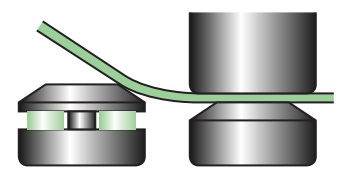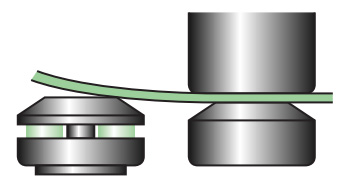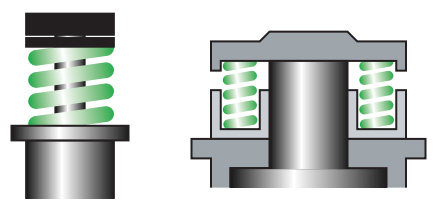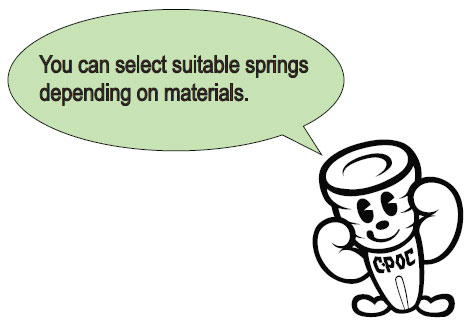Vol.22 TECHNICAL COUNSELING FAQ(2) "BURRING FOR THREAD FORM"
This time, we will introduce “tap burring” and “weak spring type tools” from the questions that we have contacted the tool consultation.
BURRING FOR THREAD FORM
The burring end-face is slanted during tap burring.
(See Fig. 1) Is there a way to resolve it?
The biggest factor that the end-face of the tap burring is slanted is the positional deviation due to the positional accuracy of the forming tool and the pre-hole tooling by the turret T number.
As a countermeasure,
-
1.
Adjust the forming position of the pre-hole punching die and burring die on the program.
If there is a tendency to tilt the burring end-face, it may be resolved by slightly changing the forming position of the pre-hole punching die.
-
2.
The pre-hole and burring are process at the same time.
Our standard burring for thread forming tool is
- ・In case of downward forming, pre-hole one process type.
- ・In case of upward forming, the type that processes the pre-hole first.
However, we also have a “pre-hole one process type with upward forming”.
Fig. 1 Burring for thread form

ADVICE ON ONE POINT
The die height of upward forming tools such as burring dies is higher than that of normal punching dies, and if the piercing is performed at a station near the forming tool, the workpiece may be damaged.
In such cases, a low height burring die is recommended.
(Applicable to t1.0 or less)
Fig.2 Comparison between standard burring die and low height burring die


ABOUT WEAK SPRING TYPE TOOL
When a sandwich steel plate is processed, a guide mark is attached to the plate and the product is not manufactured. Isn’t there anything you can do about it?
Normally, in piercing, the stronger the plate pressure, the better the shear results.
However, when processing a soft material such as a sandwich steel sheet,
the press marks on the guide or stripper may stick to the material.
As a countermeasure,
There is a method to weaken the punch spring.
We offer several types of springs.
By selecting an appropriate spring according to the material, it is possible to eliminate the holding mark.
If you can contact us, we will choose the best spring in our company.
Fig.3 Weak spring type tools


NOTICE
Using a weak spring for thick plate processing may cause a strip error.
Please use standard spring type tool for thick plate processing.
(To prevent stripping mistakes, a stripping force of 10% to 20% of the punching force is required.)
ADVICE ON ONE POINT
Other causes of guide marks include,
- ・The mounting defect of die. (Burr biting into the bottom of the die.)
- ・The defect parallelism of the guide and die end-faces.
(A failure in mounting a tool of setting during re-grinding) - ・A die (upward tooling die, etc.) with a height is mounted on a nearby station. are also considered.
-
vol.1 COUNTERMEASURES FOR SLUG PULLING IN PUNCHING PROCESS
-
vol.2 LIFE COUNTERMEASURE FOR TOOLING
-
Vol.3 TOOL MAINTENANCE
-
Vol.4 FORMING TOOL
-
Vol.5 MATERIAL FOR TOOLING
-
Vol.6 FOR CLEARANCE OF THE CUTTING DIE
-
Vol.7 ABOUT TURRET PUNCH PRESS MACHINE
-
Vol.8 VARIOUS KINDS OF SPECIAL SHAPE
-
Vol.9 PARTS NAME OF STANDARD TOOLING
-
Vol.10 EACH NAMES OF FORMING TOOL
-
Vol.11 MATERIAL PROPERTIES (STEEL)
-
Vol.12 MATERIAL PROPERTIES
-
Vol.13 CALCULATION FORMULAS FREQUENTLY USED IN SHEET METAL
-
Vol.14 HEIGHT ADJUSTMENT FREE TOOL
-
Vol.15 HOW TO DRAW AND READ DRAWINGS
-
Vol.16 HOW TO DRAW AND READ DRAWING (PRACTICAL USE)
-
Vol.17 SHAPE INSTRUCTION FOR FORMING TOOLS(1)
-
Vol.18 SHAPE INSTRUCTION FOR FORMING TOOLS(2)
-
Vol.19 CODE MANAGEMENT
-
Vol.20 BENDING TECHNICAL INFORMATION
-
Vol.21 TECHNICAL COUNSELING FAQ(1) "COUNTERMEASURES FOR GALLING"
-
Vol.22 TECHNICAL COUNSELING FAQ(2) "BURRING FOR THREAD FORM"
-
Vol.23 TECHNICAL COUNSELING FAQ(3) "PITCH OF SINGLE PIERCING"
-
Vol.24 TECHNICAL COUNSELING FAQ(4) "SHEAR OPTIONS"
-
Vol.25 TECHNICAL COUNSELING FAQ(5) "HOLDING MARK"
-
Vol.26 TECHNICAL COUNSELING FAQ(6) "SOLUTION FOR SLUG PULLING OF A SHEET METAL WITH PROTECTIVE FILM"
-
Vol.27 TECHNICAL COUNSELING FAQ(7) "MATERIAL WARPING PREVENTION DURING"
-
Vol.28 TECHNICAL COUNSELING FAQ(8) "WARPING PREVENTION OF BLANKING OUT"
-
Vol.29 TECHNICAL COUNSELING FAQ(9) "COUNTERSINK FOR COUNTERSUNK SCREW"
-
Vol.30 THE ORDERING GUIDE(1) "HOW TO INSTRUCT SHAPE AND DIMENSIONS"
-
Vol.31 THE ORDERING GUIDE(2) "REFERENCE KEY DIRECTION"
-
Vol.32 THE ORDERING GUIDE(3) "ANGLE INDICATION OF ANGLED TOOL"
-
Vol.33 THE ORDERING GUIDE(4) "SELECT SPECIFICATION OF PUNCH"
-
Vol.34 THE ORDERING GUIDE(5) "DIE SPECIFICATION SELECTION"

